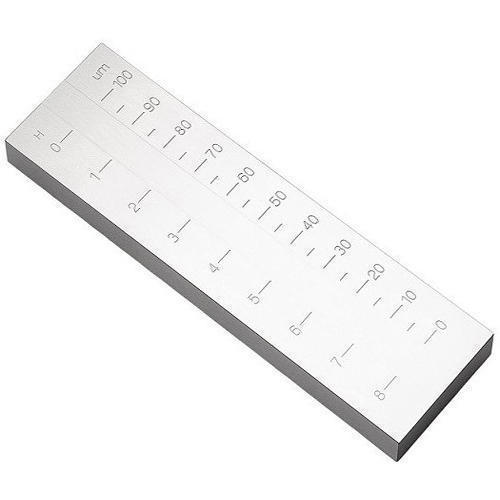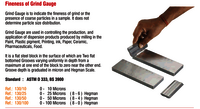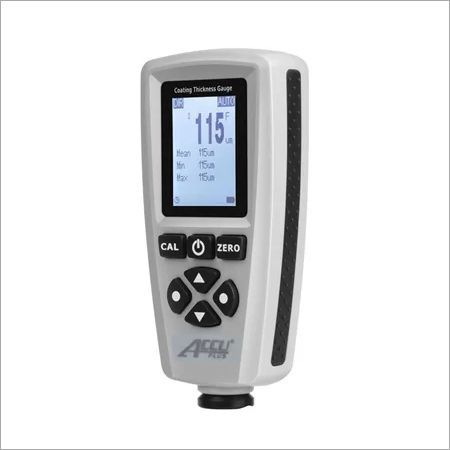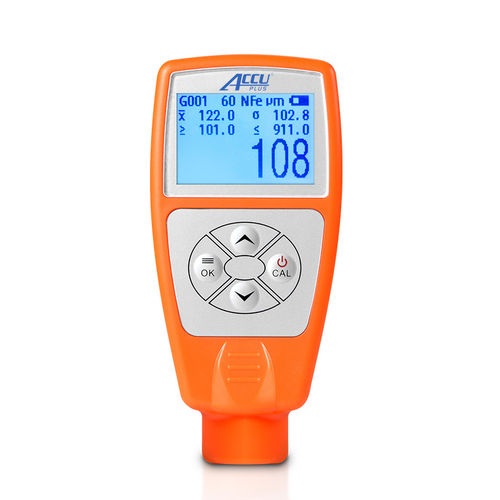- होम पेज
- कंपनी प्रोफाइल
-
हमारे उत्पाद
- वैज्ञानिक परीक्षण उपकरण
- इन्फ्रारेड थर्मामीटर MT10
- पीएच मीटर हाना
- लक्स मीटर (लाइट मीटर) LX101A LUTRON
- हाइग्रो मीटर
- प्रयोगशाला परीक्षण उपकरण
- निरीक्षण दर्पण
- O2 मीटर
- PM-9102 मैनोमीटर
- PM-9100 मैनोमीटर
- PM-9107 मैनोमीटर
- PM-9100HA मैनोमीटर
- VB-8200 वाइब्रेशन मीटर
- VB-8202 वाइब्रेशन मीटर
- VT-8204 वाइब्रेशन मीटर
- ईएमएफ-822A
- पुल ऑफ एडहेशन टेस्टर 1064
- SL-4010 प्रयोगशाला परीक्षण उपकरण
- SL-4011 लैब टेस्टिंग इंस्ट्रूमेंट
- SL-4030 लैब टेस्टिंग इंस्ट्रूमेंट
- LX-1102 लैब टेस्ट 152
- LX-1108 लैब टेस्टिंग इंस्ट्रूमेंट
- साउंड लेवल मीटर
- हाइग्रोमीटर।
- नॉन कॉन्टैक्ट टैकोमीटर
- ध्वनि स्तर मीटर
- साउंड लेवल मीटर Sl40001
- एनीमोमीटर AM4201
- एनीमोमीटर AM4200
- इन्फ्रारेड थर्मामीटर
- इन्फ्रारेड थर्मामीटर MT22
- इन्फ्रारेड थर्मामीटर MT16
- आर्द्रता और तापमान मीटर HT305
- एक्यू प्लस माप उपकरण (507024)
- सतह खुरदरापन गेज
- सतह खुरदरापन परीक्षक accu 120
- रफनेस टेस्टर
- सरफेस प्रोफाइल गेज
- शॉट एंड ग्रिट-ब्लास्टिंग कम्पैरेटर्स
- डिजिटल सरफेस प्रोफाइल गेज
- धूल संदूषण टेप
- टाइम 3100 सरफेस रफनेस टेस्टर
- सरफेस रफनेस टेस्टर एक्यूप्लस
- सरफेस रफनेस मीटर टाइम 3220
- SJ210 मिटुटोयो सरफेस रफनेस टेस्टर
- SA 2.5 सैंड एंड शॉट ब्लास्टिंग चार्ट
- 130 खुरदरापन तुलनात्मक नमूने
- सतह खुरदरापन चार्ट SA2.5
- सतह खुरदरापन चार्ट SA3
- सतह खुरदरापन चार्ट C9 GAR
- सतह खुरदरापन परीक्षक accu 200
- सतह खुरदरापन परीक्षक accu 210
- मैग्नाफ्लक्स एनडीटी उत्पाद
- डाई पेनेट्रेट टेस्ट किट
- डाई पेनेट्रेशन मटेरियल मैग्नाफ्लक्स
- 7C ब्लैक वेट मेथड ड्राई पाउडर
- WCP-2 कंट्रास्ट पेंट
- स्पॉटचेक SKC-I सॉल्वेंट क्लीनर
- वाटर वॉशेबल पेनेट्रेंट
- स्पॉटचेक SKD-S2 डेवलपर
- स्पॉटचेक SKL-SP1 पेनेट्रेंट
- Y7 मैग्नेटिक पार्टिकल योक एम/सी
- Magnaglo MG-2410 वेट मेथड फ्लोरोसेंट मैग्नेटिक पाउडर
- 7HF ब्लैक मैग्नेटिक पार्टिकल वेट मेथड रेडी बाथ
- मैग्नेटिक फ्लक्स इंडिकेटर
- मैग्नेटिक पार्टिकल टेस्ट बार
- मैग्नाविसार ड्राई मेथड नॉन-फ्लोरोसेंट मैग्नेटिक पाउडर
- मैग्नाविसार WCP-2 कंट्रास्ट पेंट
- MagNavisar 9C रेड विजिबल वेट मेथड ड्राई पाउडर कॉन्सेंट्रेट
- मैग्नाविसार 7HF ब्लैक विजिबल वेट मेथड ड्राई पाउडर कॉन्सेंट्रेट
- MagNavisar 7C ब्लैक विजिबल वेट मेथड ड्राई पाउडर कॉन्सेंट्रेट
- परिशुद्धता मापने के उपकरण
- पोर्टेबल कठोरता परीक्षक
- डिजिटल कोटिंग मोटाई गेज
- डिजिटल कोटिंग थिकनेस गेज ACCU-356B
- डिजिटल कोटिंग थिकनेस गेज DFT-111
- डिजिटल कोटिंग थिकनेस गेज FM2
- DFT-222 कोटिंग थिकनेस गेज
- डिजिटल कोटिंग थिकनेस गेज Accu-456B
- हेगमैन गेज
- वेट फिल्म थिकनेस गेज
- विस्कोसिटी कप
- इलेक्ट्रोफिजिकल कोटिंग गेज
- डिजिटल कोटिंग थिकनेस गेज ACCU 111A
- वीडियो बोरस्कोप
- बोरोस्कोप GL8898
- वीडियो बोरोस्कोप 9018
- डिजिटल कोटिंग की मोटाई Accu 3000fnf
- डिजिटल कोटिंग थिकनेस गेज एफ
- डिजिटल कोटिंग की मोटाई Accu CTG 2
- डिजिटल कोटिंग की मोटाई Accu CTG-4
- डिजिटल फोर्स गेज SF500
- वेल्डिंग गेज
- रबर कठोरता परीक्षक
- कठोरता परीक्षक
- ब्लूस्टील शोर ए हार्डनेस टेस्टर SHR - A - GOLD
- डिजिटल शोर कठोरता परीक्षक
- ब्लूस्टील रबर हार्डनेस टेस्टर शोर ए एंड शोर
- रबर हार्डनेस टेस्टर शोर ए
- डिजिटल शोर ए हार्डनेस टेस्टर
- ब्लूस्टील रबर हार्डनेस टेस्टर शोर ए और शोर डी
- शोर ए डिजिटल
- शोर डी डिजिटल
- शोर ए बेसिक
- शोर डी बेसिक
- शोर ए एक्सपोर्ट
- शोर डी एक्सपोर्ट
- शोर ए गोल्ड
- शोर डी गोल्ड
- एनडीटी उपकरण
- डिजिटल अल्ट्रासोनिक मोटाई गेज
- पाई टेप
- लेजर दूरी मीटर
- मास्टर स्तर
- प्रेस-ओ-फिल्म
- हॉलिडे डिटेक्टर
- पेंट परीक्षण उपकरण
- वैज्ञानिक परीक्षण उपकरण
- Know More
- संपर्क करें
हेगमैन गेज
उत्पाद विवरण:
- रंग चाँदी
- चौड़ाई 10-50 मिलीमीटर (mm)
- उपयोग औद्योगिक और प्रयोगशाला उपयोग के लिए
- मटेरियल स्टेनलेस स्टील
- ग्रेड औद्योगिक श्रेणी
- एप्लीकेशन ऑयल रिफाइनरीज मरीन इंजीनियरिंग टेक्सटाइल उद्योग रासायनिक प्रसंस्करण पेट्रो केमिकल प्लांट्स फार्मास्युटिकल निर्माण मैकेनिकल इंजीनियरिंग न्यूक्लियर पावर इंजीनियरिंग
- अधिक देखने के लिए क्लिक करें
X
हेगमैन गेज मूल्य और मात्रा
- टुकड़ा/टुकड़े
- 1
- टुकड़ा/टुकड़े
हेगमैन गेज उत्पाद की विशेषताएं
- चाँदी
- स्टेनलेस स्टील
- ऑयल रिफाइनरीज मरीन इंजीनियरिंग टेक्सटाइल उद्योग रासायनिक प्रसंस्करण पेट्रो केमिकल प्लांट्स फार्मास्युटिकल निर्माण मैकेनिकल इंजीनियरिंग न्यूक्लियर पावर इंजीनियरिंग
- औद्योगिक और प्रयोगशाला उपयोग के लिए
- 10-50 मिलीमीटर (mm)
- औद्योगिक श्रेणी
हेगमैन गेज व्यापार सूचना
- 100 प्रति दिन
- 1 दिन
- ऑल इंडिया
उत्पाद वर्णन
A Hegman gauge, sometimes referred to as a grind gauge, grind gage, or grindometer, is an instrument which indicates the fineness of grind or the presence of coarse particles and agglomeration in a dispersion.[1] It is commonly used to determine how finely ground the particles of pigment (or other solid) dispersed in a sample of paint (or other liquid) are. This is important because many types of solid materials must be ground into finer particles in order to be dispersed in liquids.[2] The resulting properties of the dispersion vary based on the size of individual particles and the degree which they are dispersed.
The Hegman gauge usually consists of a stainless steel block with a series of very small parallel grooves machined into it. The grooves decrease in depth from one end of the block to the other, according to a scale stamped next to them. A typical Hegman gauge is 170mm by 65mm by 15mm, with a channel of grooves running lengthwise, 12.5mm across and narrowing uniformly in depth from 100 m to zero and used to determine
[edit]
A Hegman gauge is used by placing a sample of paint at the deep end of the gauge and drawing the paint down with a flat edge along the grooves. Grind gages are sold with machined flat 'drawdown bars' specifically for this purpose. The paint fills the grooves, and the location where a regular, significant "pepperyness" in the appearance of the coating appears, marks the coarsest-ground dispersed particles.[3] This is the point where oversized particles start to appear in high density and determines the rating for that material.[4] The reading is taken from the scale marked next to the grooves, in dimensionless "Hegman units" (or National Standard units; NS) and/or mils or micrometres.[5] Hegman units are defined in terms of an inverted size scale as shown below:[6]
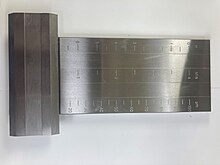 Hegman Grind Gage and doctor blade
Hegman Grind Gage and doctor blade Paint sample at top of Hegman
Paint sample at top of Hegman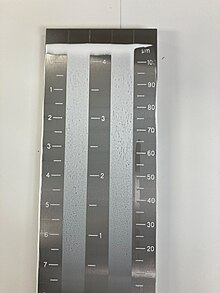 Hegman after paint drawdown
Hegman after paint drawdown| Hegman Units | Mils | Microns |
|---|---|---|
| 0 | 4.0 | 101.6 |
| 1 | 3.5 | 88.9 |
| 2 | 3.0 | 76.2 |
| 3 | 2.5 | 63.5 |
| 4 | 2 | 50.8 |
| 5 | 1.5 | 38.1 |
| 6 | 1 | 25.4 |
| 7 | 0.5 | 12.7 |
| 8 | 0 | 0 |
A lesser-used scale, North (or PCU), is also occasionally employed in the paint industry. Like the Hegman scale, this is also inverted compared to the value in microns:
| Microns | North units |
|---|---|
| 0 | 100 |
| 10 | 90 |
| 20 | 80 |
| 30 | 70 |
| 40 | 60 |
| 50 | 50 |
| 60 | 40 |
| 70 | 30 |
| 80 | 20 |
| 90 | 10 |
| 100 | 0 |
Determining the fineness of a paint's grind is important, because too coarse a grind may reduce the paint's color uniformity, gloss, and opacity.[7] The Hegman gauge is widely used for this purpose because it requires minimal skill and only a few seconds' work.[3]
Tell us about your requirement

Price: Â
Quantity
Select Unit
- 50
- 100
- 200
- 250
- 500
- 1000+
Additional detail
मोबाइल number
Email
डिजिटल कोटिंग मोटाई गेज अन्य उत्पाद
हम मुख्य रूप से गुजरात में सौदा करते हैं
Back to top


